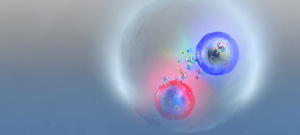A quantum state never before seen at the Large Hadron Collider is confirmed
The international collaboration operating the ATLAS experiment at CERN’s Large Hadron Collider (LHC) reported in early July the observation of toponium, a bound state of the heaviest elementary particles, the top quark. In physics, this is known as a “quasi‑bound state”—a temporary union between particles that is unstable and eventually decays. For decades, this state was thought to be impossible to detect. Now, the ATLAS experiment confirms the same toponium observation previously made by the CMS experiment, also at the LHC. A team from the Instituto de Física Corpuscular (IFIC)—a joint center of the Spanish National Research Council (CSIC) and the University of Valencia (UV)—has played an important role in detecting this new quantum system.
Everything we see in the universe, ourselves included, is made up of quarks. Among them, the top quark is, by its nature, a solitary particle. Unlike other quarks, which can combine to form hadrons (such as the protons that make up atomic nuclei), the top quark decays almost instantaneously, without enough time to form bound states. In physics, a bound state is one in which a particle is trapped in a region of space with other particles because it does not have enough energy to escape—it is stable. In contrast, a quasi‑bound state allows the particle to escape and is therefore temporary and unstable.
Quantum mechanics—the physics that explains the behavior of atoms and particles—allows under exceptional conditions for a top quark and its antiparticle, the top antiquark, to survive long enough to interact and form toponium, a quasi‑bound state with an extremely brief lifetime. However, for decades it was considered practically impossible to detect such a state at the LHC—the world’s largest particle accelerator—where scientists collide protons at near‑light speeds to recreate conditions similar to those at the birth of the universe.
New Quasi‑Bound State
Some time ago, an unusual signal was observed in one of the LHC’s major experiments, CMS, in data collected between 2016 and 2018: an excess of top quark–antiquark pairs (antiparticles identical in every way except for electric charge). While such an excess can sometimes signal new particles, the precise location of the phenomenon led the team to consider a different possibility: the formation of toponium. On 8 July, the ATLAS collaboration—comprising over 5,000 scientists and engineers worldwide—independently announced the observation of the same phenomenon, based on data taken between 2015 and 2018. The results are in close agreement with those from CMS, strengthening the interpretation that this is a new quasi‑bound quantum state called toponium.
Participation of IFIC
The IFIC has been involved in the ATLAS experiment at the LHC since its inception, with a prominent role in the top quark physics group. CSIC researcher at IFIC Marcel Vos contributed to the peer review of this result. Vos also coordinates the LHC Top Working Group, the team responsible for all results related to the top quark at the LHC. “Since the detection of the top quark in 1995, the production and properties of this particle and its antiparticle have been studied in great detail,” Marcel Vos explains. “For years it was believed that a bound state such as toponium would be undetectable, since the effects of this union were too subtle. But analyses by ATLAS and CMS demonstrate that the LHC has been able to detect this fleeting union between a top quark and a top antiquark, resulting in this new quasi‑bound state that was predicted as early as 1990, even before the discovery of the top quark,” the CSIC scientist affirms.
Despite clear evidence that an unexpected phenomenon is being observed, the ultimate origin of toponium still remains to be clarified. One alternative explanation could be the existence of a new particle with a mass close to twice that of the top quark. These results show that there is still much to explore in the Standard Model of particle physics, the theory that best describes the visible universe. If the observation of toponium is confirmed, this discovery would mark a new milestone in our understanding of the most fundamental constituents of the universe.
Reference: Results from the ATLAS Collaboration presented at the European Physical Society’s High-Energy Physics Conference, Marseille (France).




















